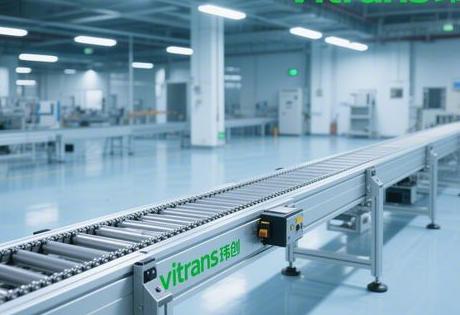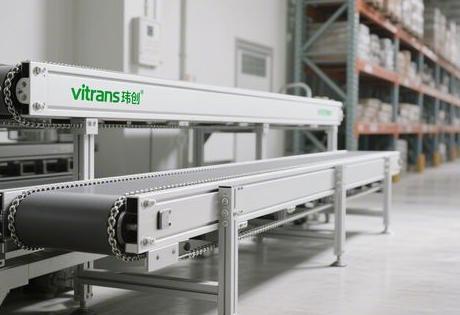"How precise is 0.05 mm? Let's put it this way, a strand of hair is about 0.07 mm in diameter!
You taste, you fine - now you have to put dozens of kilograms of machine parts, running around on the assembly line, every time you stop the position, the error must be finer than a hair. This thing does not sound quite mysterious? But Changning this set of ring guide conveyor line, really did ± 0.05mm accuracy. Guess what? It is not relying on what black magic, but the actual "bipartite locating method".

I. Where the hell did this accuracy come from?
To put it bluntly, it's a two-step process, one step for roughing and one step for finishing:

- Step 1: "Rough positioning": The servomotor drives the carriage to near the target position with an error of about ±0.1mm. This step is similar to when you drive into a garage - first park roughly to the side of the space.
- Step 2 "Finishing Bits": Addition of key stations (e.g. where parts need to be grasped by the robot)Locating cylinder or locating pinAfter the slide is in place, the side cylinder "clicks" into place. After the slide is in place, the side cylinders "click" a top, the slide is firmly stuck into the precise position of ± 0.05mm.
It's like fine-tuning your steering wheel in a parking space and ending up with the wheel stuck tightly in the parking compartment.
Why do I have to do it twice? Because the ring guide is driven by the belt or chain, transmission is inevitable gap. Just like you pull the rope to pull the box, the rope is loose and tight, the box position will shake. Secondary positioning is equivalent to adding a "buckle" to the box to completely eliminate shaking.

Second, compared with traditional equipment, where is it strong?
Many factories are still using the old-fashioned carousel divider (also called "indexing disc") or linear conveyor line, but the first spell of accuracy and efficiency will be timid:
| comparison term | Conventional Divider | Changning Ring Guide |
|---|---|---|
| position accuracy | ±0.1mm or more | ±0.05mm(High-precision scene) |
| sports | Intermittent rotation (stop and go) | Continuous motion + stopping at any position |
| Number of workstations | General ≤ 16 | Dozens or even hundreds of workstations |
| Maintenance frequency | Monthly lubricant check | Maintenance only once a year |
| space occupation | The roundabout occupies the centre. | Straight/rectangular layout, stick to the wall to save space |
The worst thing is the "secondary location" problem.Traditional production lines have to add an extra cylinder to push the workpiece into place before the robot assembles it. Traditional production lines have to add an extra cylinder to push the workpiece into place before the robot is assembled, which slows down the pace (it can take up to 0.5 seconds longer) and increases the number of failure points. Ring guidewayOne stop, no reworkThe process is simply eliminated.
Third, which industries rush to use it?
To be honest, willing to spend a lot of money on the ± 0.05mm accuracy, are on the "difference of a millimetre lost million" zero tolerance industry:
- Assembly of medical consumablesFor example, heart stents and injection needles are as small as grains of rice, and a robot that grabs them 0.1mm out of position can poke through the bag.
- New Energy Battery AssemblyLithium battery electrode sheet is as thin as paper, when stacking the sheet misalignment of more than 0.05mm may be short-circuited, directly into a "bomb".
- Semiconductor TestingThe circuit line width on the wafer surface is miniaturised to the nanometre level, and amplitudes of more than 0.5μm (0.0005mm) during transport can affect imaging, which the ring guide's anti-micro-vibration design is just able to suppress.
Don't think that only the most sophisticated can afford it.Now the modular design is mature! Now that the modular design is mature, factories like Changning can customise the length of the track according to their needs (640mm-6000mm can be cut at will), and small and medium-sized production lines can be mounted in sections, without having to empty the bottom of the house at one time.
Fourth, the boss is most concerned about: expensive? Save money or not?
Let's be honest: the upfront investment is more expensive than ordinary conveying linesAfter all. After all, the guide rail to be ground and processed, rollers have to import bearings, control systems also have to be equipped with servo. But stretched to three years accounting, but may be more cost-effective:
- Save 30% on your electricity bill: Aluminium alloy links are lighter than steel chains and the motor drags without effort;
- Maintenance fees cut in half: It's only serviced once a year, so you don't have to have a mechanic on hand to keep an eye on it;
- Fewer breakdowns and production stoppages: Secondary positioning faults? Doesn't exist. Fewer machine stops, more lines earned.
My personal observations
Dried more than ten years of automation, I have seen a lot of plants planted in the "precision will be" - always think that the difference of 0.1mm does not matter, the result is that the defective rate remains high, rework costs enough to buy two sets of new rails.
Changning this ± 0.05mm programme, ostensibly a technological breakthrough.The kernel is really "high precision for low complexity".The trouble is left to the equipment provider. Leave the trouble to the equipment provider, to save the heart to the production line - less adjustment equipment, less repair machines, less staring at the screen alarm, which is called the real "cost reduction and efficiency".
Where the future fight is how fast the machine is running, is more than whose production line "stupid black sweet": stupid in the operation is simple, black in the technical hard core, sweet in the boss counting money without frowning.













